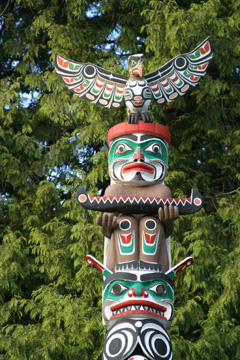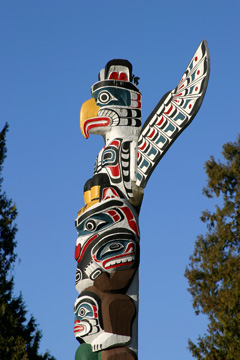| ABORIGINAL ART IN CANADA |
 |
Within Canadian Aboriginal or First Nations art fall nearly as many styles as different tribes. These various styles can for the most part be classified as one of three primary schools of Aboriginal Art in Canada:
- West Coast Art
- Eastern Woodlands Art
- Inuit Art
In this article, we will explore these three distinct regions, their artistic styles, and the artists who have sought to and succeeded in establishing the recognition of European Canadian culture with their unique artwork.
|
SUMMARY
In addition to discussing the styles of these different artistic cultures, we will look at some of the artists who worked, or currently work, in each style.
| WEST COAST ART |
EAST COAST ART |
INUIT ART |
- Robert Davidson
- Bill Reid
- Emily Carr
|
- Norval Morrisseau
- Jordan Bennett
- Daphne Odjig
|
- Annie Pootoogook
- Andrew Qappik
- Kenojuak Ashevak
|
|
| WEST COAST ART
|
 |
CENTRAL PLATEAU OF BC
The plateau region of British Columbia has long been inhabited by tribes of the Interior Salish region - the Lillooet, Thompson, Okanagan and Shuswap. Historically, these tribes were known for their beautiful woven baskets, often made using birch bark and tree roots, wound in a unique coiling style to create a continuous spiral pattern. Using bark and goat wool, they also wove intricate mats and blankets. Their work was usually colourful, with geometric patterns.
Interior Salish peoples also created carvings from bone, antler, and stone. The carvings depicted primarily animal and human subjects.
NORTHWEST COAST
This Northwest Coast style was developed more than 3,000 years ago, by artists in tribes like the Haida and the Kwakiutl, who lived along the coast between Vancouver, BC and Alaska. In addition to the two-dimensional artwork that has become highly recognizable, they are also known for their totem pole and mask carvings.
Northwest Coast artists are credited with establishing the "formline" in their art, which was incorporated into southern regions by the 20th century. Highly recognizable, the formline is a thick line, usually black, that expands and shrinks as it winds through the art, continuous and curving. Red and black are the primary colours used, when paint is incorporated into the designs.
In addition to the black outline, red is the colour most commonly used in traditional Northwest Coast artwork. Subjects may include animals, people, and legendary creatures. Often two animals are depicted of one body, and a single feature of an animal - a bird's beak or a whale's fin - is accepted as representing the entire animal.
Northwest Coast artists and carvers are the primary creators of totem poles, which are discussed in the following section.
WESTERN ARTISTS
Robert Davidson
Robert Davidson (b. 1946) is considered a prominent figure in the re-emergence of Haida art and culture. He was raised and studied in Vancouver, and in 1969 created the first totem pole raised in Haida Gwaii (formerly the Queen Charlotte Islands) in almost 100 years.
Bill Reid
British Columbia artist Bill Reid (1920-1998) is best known for his sculptures that can be seen around BC, as well as his jewelry, paintings, and screen printing. His designs were featured on the Canadian $20 bill from 2004 to 2012. He was heavily inspired by the First Nations culture surrounding him, and his own Haida heritage.
Emily Carr
Though not Aboriginal herself, nationally-renowned painter Emily Carr (1871-1945) was inspired by the Indigenous peoples of the Pacific Northwest Coast. Carr spent much of her working life in Victoria, and painted landscapes and First Nations communities along the British Columbia coast. She depicted her natural scenes in modernist and post-modernist styles.
|

Northwest Coast totem pole
|
| TOTEM POLE ART
|
 |
|
Though widely recognized as synonymous with First Nations culture in general, the totem pole is originally and primarily a feature of Northwest Coast Aboriginal culture and art. Built to serve a variety of functions, totem poles depict animals related to specific family crests, and often include beavers, bears, wolves, ravens, eagles, frogs, and other important creatures. Different Indigenous groups practice different styles and prefer different purposes for their totem poles.
There are six types of totem poles:
- Memorial poles
- Grave figures
- House posts
- Portal poles
- Welcoming poles
- Mortuary poles
The poles are generally carved from red cedar, and are painting primarily in black, white, red, blue, and yellow. Though the size varies depending on space and significance, some poles can be as wide as a metre (3.3 feet) across, and more than 20 metres tall (65 feet).
Most of the poles we see today were most likely created after the mid-1800s, but the building and carving of totem poles has taken place since before European contact with First Nations peoples.
Robert Davidson and Bill Reid, two of the artists mentioned above, have created totem poles in the Northwest Coast tradition. Other contemporary carvers include Ellen Neel (d. 1966), Norman Tait (b. 1941), and Tony Hunt (b. 1942).
|

Totem pole top detail
|
| EAST COAST ART
|
 |
EASTERN WOODLANDS
The tribes of the Eastern Woodlands were divided into two language groups, the Iroquoian (southern Ontario and the northern states) and the Algonquian (Lake Superior to the Ottawa Valley, and the Atlantic provinces). Within these two groups are many different tribes.
Eastern Woodlands tribes are known for the creation of Dreamcatchers: decorative nets woven into hoops that were intended to capture bad dreams. Dreamcatchers have become quite well-known in popular culture in recent decades. They also used beads and quills to create intricate patterns on clothing and other artwork.
The Woodland Art school developed largely from the work of artist Norval Morriseau. Even today, though contemporary culture influences the art, many of the techniques are carried on from ancient times. Transformative imagery is common, such as creatures that are both man and beast, images showing humans in struggle with animals, and a merging of background and subject.
EASTERN ARTISTS
Norval Morrisseau
Celebrated Ontario artist Norval Morrisseau (1932-2007) was known as the "Picasso of the North," and was a founder of the Woodlands School of Canadian art. His signature style included thick black lines and bright colour. He was a member of the Indian Group of Seven.
Jordan Bennett
Mi'kmaq artist Jordan Bennett combines history and pop culture, traditional craft influences, and personal cultural experience to create sculpture, installation, performance, and digital art.
Daphne Odjig
Daphne Odjig (b. 1919) is an Ontario artist who paints in the Woodland style. She has received the Order of Canada (1986) and the Governor General's Award (2007) for her paintings and pen and ink drawings. Her work has been exhibited in many countries around the world.
|


|
| INUIT ART
|
 |
|
The Eskimo peoples of Canada's north - of which there are various groups - are believed to have originally crossed the Bering Strait some 4000 years ago. The culture changed and evolved, as did the art, over the following centuries. But the "Eskimo" or "Inuit" art that we think of today did not exist in its currently recognizable form until around the 1950s.
Soapstone and ivory carvings were some of the first contemporary Inuit artworks, and are recognizable and much sought after today. Printmaking has also emerged as a lucrative artistic trade in Inuit communities. Though drawings and paintings are also available, they are not as popular as the prints.
Though the materials used are echoed across the northern expanses, there is much local and regional variation in style and subject matter. Traditional lifestyle is depicted, as are survival techniques, northern animals, and spiritual images. Different artists have begun developing their own unique styles.
INUIT ARTISTS
Annie Pootoogook
Annie Pootoogook (b. 1969) is a well-known Inuit artist whose two-dimensional artworks, using pencil crayon and other media, depict both the friendly familial and dangerous sides of life in the Canadian North. Her work has been shown in numerous high profile exhibitions.
Andrew Qappik
Andrew Qappik (b. 1964) is a Nunavut-born graphic artist who designed and consulted on various Nunavut government logos. The polar bear used by the Government of Nunavut is his design. Primarily a printmaker, Qappik's art depicts animals and Inuit culture based on his own experiences and stories told by his relatives.
Kenojuak Ashevak
Kenojuak Ashevak (1927-2013) was an Inuit artist known for her soapstone carvings, drawings, etchings, and printmaking. She was the subject of the National Film Board documentary "Eskimo Artist: Kenojuak" (1963). She was the first Inuit artist commissioned to create a chapel stained glass window, at Appleby College in Oakville, Ontario.
|


|
|
If you have questions about the services or products offered by KeenART Media, don't hesitate to contact us. Our knowledgeable staff is always happy to assist with answers, advice, or suggestions.
|
|
© 2002-2026 - KeenART Media Ltd.
|
|
| |
|

